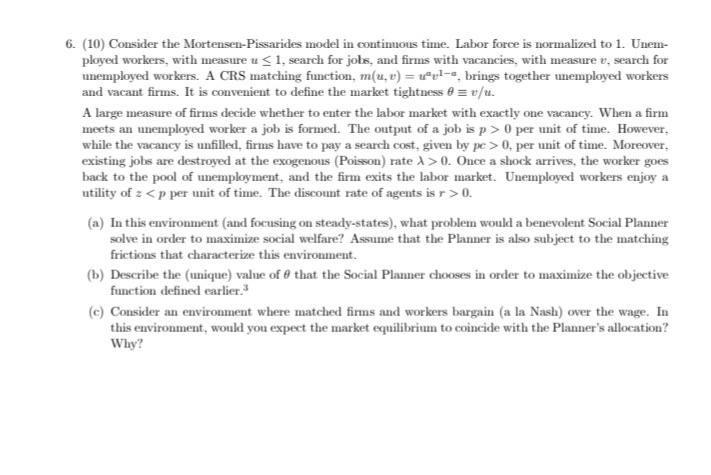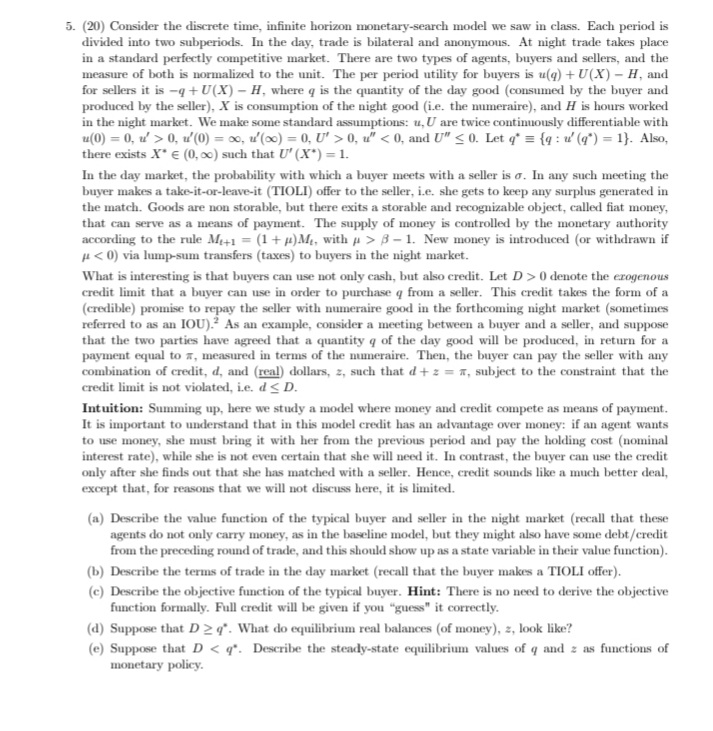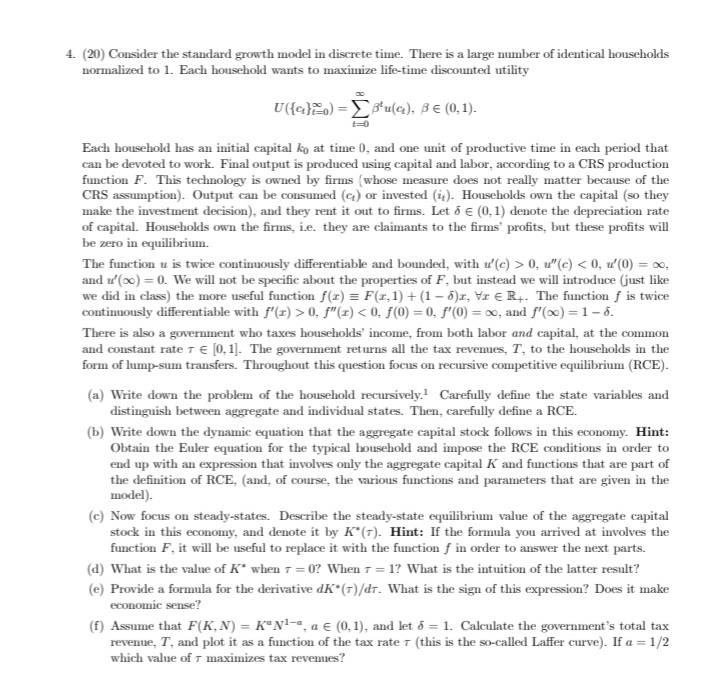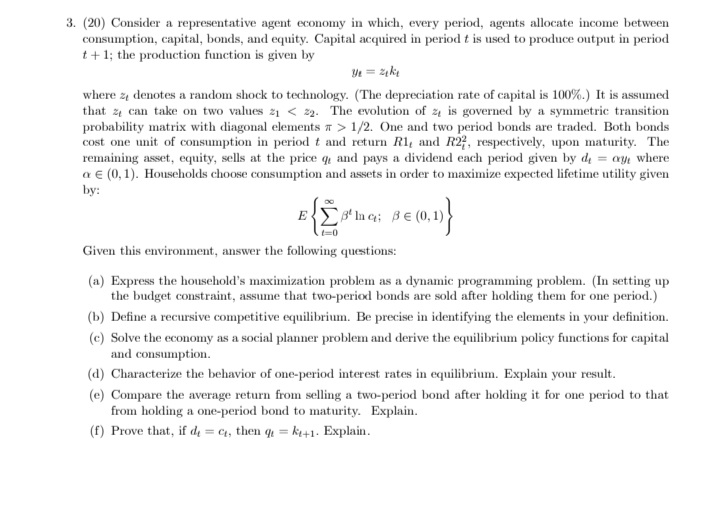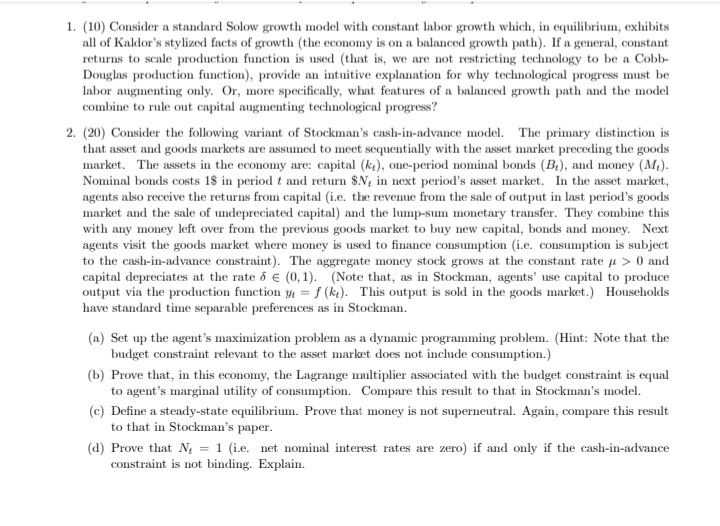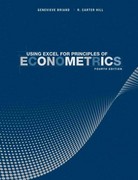6. (10) Consider the Mortensen-Pissarides model in continuous time. Labor force is normalized to 1. Unem- ployed workers, with measure u 0 per unit of time. However, while the vacancy is unfilled, firms have to pay a search cost, given by pc > 0, per unit of time. Moreover, existing jobs are destroyed at the exogenous (Poisson) rate A > 0. Once a shock arrives, the worker goes back to the pool of unemployment, and the firm exits the labor market. Unemployed workers enjoy a utility of = 0. (a) In this environment (and focusing on steady-states), what problem would a benevolent Social Planner solve in order to maximize social welfare? Assume that the Planner is also subject to the matching frictions that characterize this environment. (b) Describe the (unique) value of o that the Social Planner chooses in order to maximize the objective function defined earlier.3 (c) Consider an environment where matched firms and workers bargain (a la Nash) over the wage. In this environment, would you expect the market equilibrium to coincide with the Planner's allocation? Why?5. (20) Consider the discrete time, infinite horizon monetary-search model we saw in class. Each period is divided into two subperiods. In the day, trade is bilateral and anonymous. At night trade takes place in a standard perfectly competitive market. There are two types of agents, buyers and sellers, and the measure of both is normalized to the unit. The per period utility for buyers is u(q) + U(X) - H, and for sellers it is -q + U(X) - H, where q is the quantity of the day good (consumed by the buyer and produced by the seller), X is consumption of the night good (i.e. the numeraire), and H is hours worked in the night market. We make some standard assumptions: u, U are twice continuously differentiable with "(0) = 0, u' > 0, u'(0) = 00, u'(co) = 0, U' > 0, u" 8 - 1. New money is introduced (or withdrawn if 0 denote the erogenous credit limit that a buyer can use in order to purchase q from a seller. This credit takes the form of a (credible) promise to repay the seller with numeraire good in the forthcoming night market (sometimes referred to as an IOU)." As an example, consider a meeting between a buyer and a seller, and suppose that the two parties have agreed that a quantity q of the day good will be produced, in return for a payment equal to #, measured in terms of the numeraire. Then, the buyer can pay the seller with any combination of credit, d, and (real) dollars, z, such that d + 2 = *, subject to the constraint that the credit limit is not violated, i.e. d s D. Intuition: Summing up, here we study a model where money and credit compete as means of payment. It is important to understand that in this model credit has an advantage over money: if an agent wants to use money, she must bring it with her from the previous period and pay the holding cost (nominal interest rate), while she is not even certain that she will need it. In contrast, the buyer can use the credit only after she finds out that she has matched with a seller. Hence, credit sounds like a much better deal, except that, for reasons that we will not discuss here, it is limited. (a) Describe the value function of the typical buyer and seller in the night market (recall that these agents do not only carry money, as in the baseline model, but they might also have some debt/credit from the preceding round of trade, and this should show up as a state variable in their value function). (b) Describe the terms of trade in the day market (recall that the buyer makes a TIOLI offer). (c) Describe the objective function of the typical buyer. Hint: There is no need to derive the objective function formally. Full credit will be given if you "guess" it correctly. (d) Suppose that D 2 q". What do equilibrium real balances (of money), 2, look like? (e) Suppose that D 0, u"(c) 0, f"(x) 1/2. One and two period bonds are traded. Both bonds cost one unit of consumption in period & and return Rl, and R2, respectively, upon maturity. The remaining asset, equity, sells at the price q and pays a dividend each period given by d = ay, where or E (0, 1). Households choose consumption and assets in order to maximize expected lifetime utility given by: Est Ina; BE (0, 1) 1=0 Given this environment, answer the following questions: (a) Express the household's maximization problem as a dynamic programming problem. (In setting up the budget constraint, assume that two-period bonds are sold after holding them for one period.) (b) Define a recursive competitive equilibrium. Be precise in identifying the elements in your definition. (c) Solve the economy as a social planner problem and derive the equilibrium policy functions for capital and consumption. (d) Characterize the behavior of one-period interest rates in equilibrium. Explain your result. (e) Compare the average return from selling a two-period bond after holding it for one period to that from holding a one-period bond to maturity. Explain. (f) Prove that, if do = co, then q = ki+1. Explain.1. (10) Consider a standard Solow growth model with constant labor growth which, in equilibrium, exhibits all of Kaldor's stylized facts of growth (the economy is on a balanced growth path). If a general, constant returns to scale production function is used (that is, we are not restricting technology to be a Cobb- Douglas production function), provide an intuitive explanation for why technological progress must be labor augmenting only. Or, more specifically, what features of a balanced growth path and the model combine to rule out capital augmenting technological progress? 2. (20) Consider the following variant of Stockman's cash-in-advance model. The primary distinction is that asset and goods markets are assumed to meet sequentially with the asset market preceding the goods market. The assets in the economy are: capital (), one-period nominal bonds (B;), and money (M.). Nominal bonds costs 1$ in period t and return $N, in next period's asset market. In the asset market, agents also receive the returns from capital (i.e. the revenue from the sale of output in last period's goods market and the sale of undepreciated capital) and the lump-sum monetary transfer. They combine this with any money left over from the previous goods market to buy new capital, bonds and money. Next agents visit the goods market where money is used to finance consumption (i.e. consumption is subject to the cash-in-advance constraint). The aggregate money stock grows at the constant rate ( > 0 and capital depreciates at the rate s e (0, 1). (Note that, as in Stockman, agents' use capital to produce output via the production function y = f (k). This output is sold in the goods market.) Households have standard time separable preferences as in Stockman. (a) Set up the agent's maximization problem as a dynamic programming problem. (Hint: Note that the budget constraint relevant to the asset market does not include consumption.) (b) Prove that, in this economy, the Lagrange multiplier associated with the budget constraint is equal to agent's marginal utility of consumption. Compare this result to that in Stockman's model. (c) Define a steady-state equilibrium. Prove that money is not superneutral. Again, compare this result to that in Stockman's paper. (d) Prove that Me = 1 (i.e. net nominal interest rates are zero) if and only if the cash-in-advance constraint is not binding. Explain
